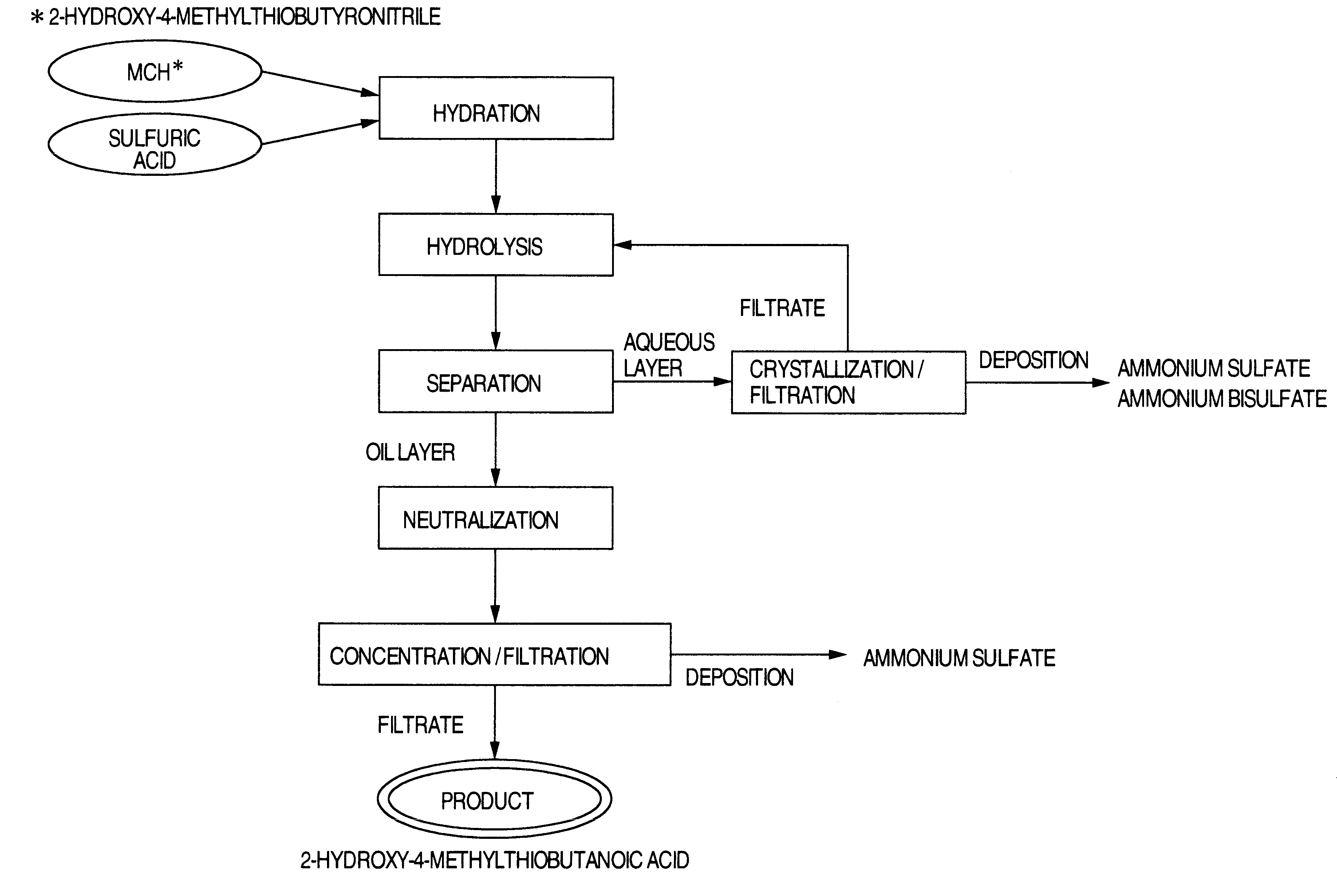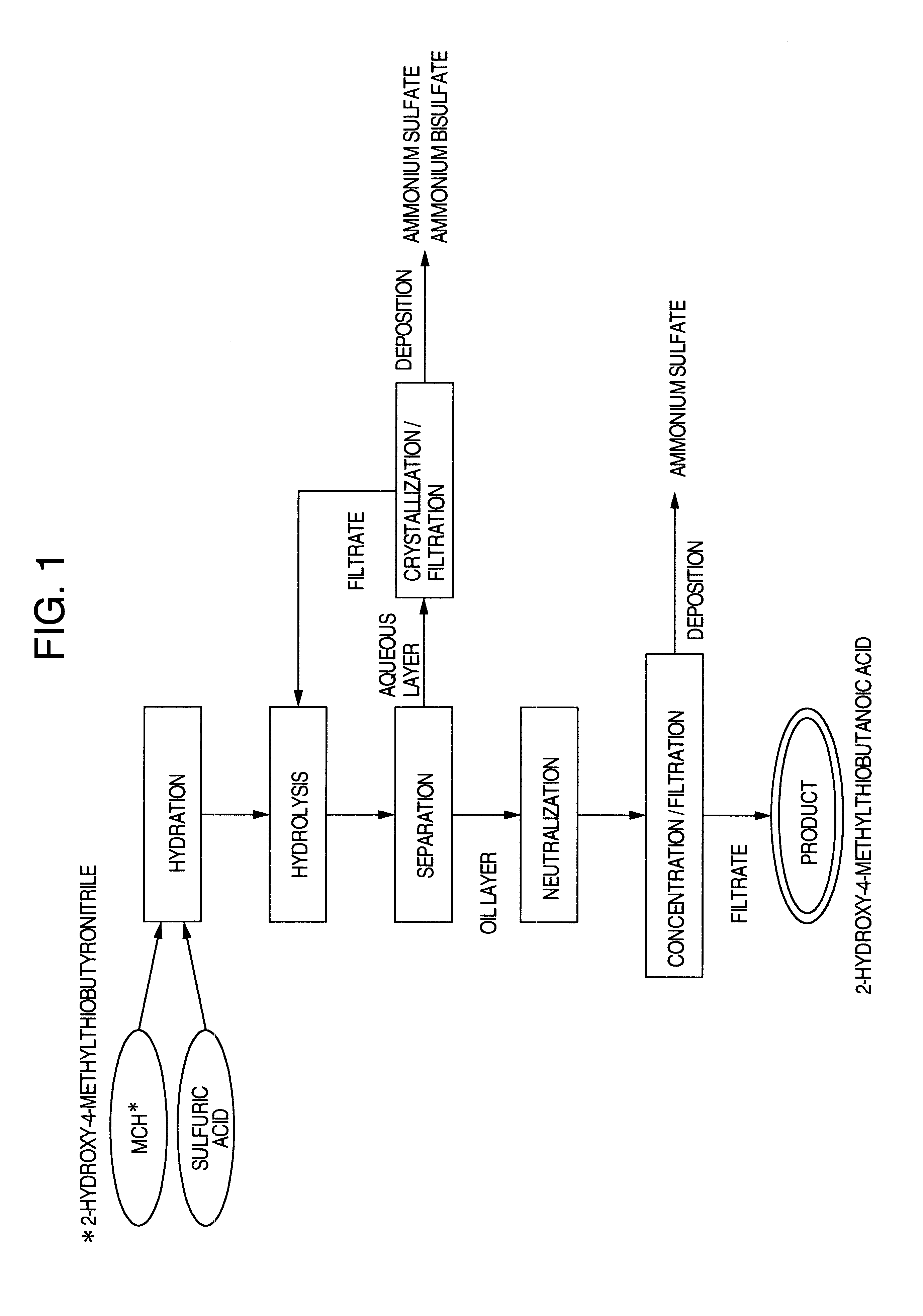Process for producing 2-hydroxy-4-methyl-thiobutanoic acid
a technology of thiobutanoic acid and hydroxy-4-methyl thiobutanoic acid, which is applied in the preparation of carboxylic compounds, organic chemistry, chemistry apparatus and processes, etc., can solve the problems of difficult to reduce environmental load markedly, method which uses organic solvents cannot be regarded as the best one, and method which is not so advantageous, so as to promote hydrolysis and reduce the amount of ammonium
- Summary
- Abstract
- Description
- Claims
- Application Information
AI Technical Summary
Benefits of technology
Problems solved by technology
Method used
Image
Examples
example 1
To 196.8 g (1.4 moles) of a 70% aqueous sulfuric acid solution was added by drops, while stirring, 294.1 g (2.0 moles) of an 89.2% aqueous 2-hydroxy-4-methylthiobutyronitrile solution over 30 minutes. The inner temperature of the reaction mixture during the above dropwise addition was controlled so as to be about 50.degree. C. After completion of the dropwise addition, the resulting mixture was stirred for further two hours while the inner temperature being kept at 50.degree. C., to effect hydration.
To the resulting mixture were then added each of
(a) 228.7 g of water,
(b) a solution of 94.0 g of ammonium bisulfate dissolved in 228.7 g of water,
(c) a solution of 94.0 g ammonium bisulfate and 39.6 g of ammonium sulfate dissolved in 228.7 g of water,
(d) a solution of 94.0 of ammonium bisulfate and 52.8 g of ammonium sulfate dissolved in 228.7 g of water, and
(e) a solution of 94.0 g of ammonium bisulfate and 79.3 g of ammonium sulfate dissolved in 228.7 g of water. The resulting mixtures...
example 2
Each of the mixtures after the hydrolysis effected by the addition of (a) to (e) of Example 1 was allowed to stand and to separate into two layers. Then the mixtures were kept at 70.degree. C. and allowed to stand to respectively separate an oil layer and an aqueous layer from each other. Then the respective layers were analyzed for their respective contents of 2-hydroxy-4-methylthiobutanoic acid (abbreviated as HMBA in Tables), ammonium bisulfate and ammonium sulfate. The results obtained are shown in Table 2 for the oil layer and in Table 3 for the aqueous layer.
The component analysis of the oil layer and the aqueous layer was conducted by liquid chromatography for 2-hydroxy-4-methylthiobutanoic acid and by ion chromatography for ammonium bisulfate and ammonium sulfate. The units are all in mole.
TABLE 3
example 3
The ammonium bisulfate in the oil layer (456.1 g) obtained in (c) of Example 2 was neutralized with a sufficient amount of an 25% aqueous ammonia solution (45 g). The resulting liquid was divided into 6 portions. Each portion was concentrated to the concentrating rate shown in Table 4, then cooled to room temperature and filtered to obtain 2-hydroxy-4-methylthiobutanoic acid product as the filtrate. The water content and the sulfate ion concentration in the product obtained at each concentration rate are shown in Table 4.
The sulfate ion concentration was determined by using ion chromatography and the water content by using a moisture meter by Karl Fischer's method.
PUM
| Property | Measurement | Unit |
|---|---|---|
| temperature | aaaaa | aaaaa |
| temperature | aaaaa | aaaaa |
| temperature | aaaaa | aaaaa |
Abstract
Description
Claims
Application Information
 Login to View More
Login to View More - R&D
- Intellectual Property
- Life Sciences
- Materials
- Tech Scout
- Unparalleled Data Quality
- Higher Quality Content
- 60% Fewer Hallucinations
Browse by: Latest US Patents, China's latest patents, Technical Efficacy Thesaurus, Application Domain, Technology Topic, Popular Technical Reports.
© 2025 PatSnap. All rights reserved.Legal|Privacy policy|Modern Slavery Act Transparency Statement|Sitemap|About US| Contact US: help@patsnap.com


